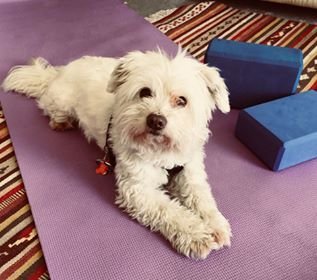Choosing a Yoga Teacher Training
by Jeanna Lurie
"Scrubbles" wants to be a Yoga Teacher
Back in the 90’s, when the electronic music scene was big in the Bay Area, it seemed like everyone wanted to be a DJ. There was even a song, “(I Just Want to Be A) Drummer” that listed all the people who wanted to be a DJ: “....my girlfriend wants to be a DJ, my cat wants to be a DJ, my goldfish wants to be a DJ…” Perhaps it just seemed that way because back then that was my social scene and I was DJing. Now that I’ve been teaching yoga for nearly 15 years, and managing a studio for a decade, it seems like everyone wants to be a yoga teacher. And a majority of yoga studios are capitalizing on this by offering teacher trainings. Most commonly offered is a 200-hour basic training and many studios offer advanced or specialized trainings, as well.
However, like DJing, the teaching of yoga is not a regulated industry. In other words, any person could call him or herself a yoga teacher and offer public classes or open a studio. But DJing is simply a creative endeavor, while teaching yoga puts the safety and well-being of others in the instructor’s hands. Currently, no degree, certificate, or licensure is legally required to teach yoga. Any person could claim to teach yoga, and it’s shocking to hear of people leading classes while admitting they had no formal training! In an effort to address this issue, the Yoga Alliance, a non-profit founded in 1997, has created industry standards with a process in place to recognize teacher training programs and the people who complete them, but their system is rather flawed. (More on that later…) In the meantime, here are a few things to consider when choosing a yoga training:
Instructors. Obviously you want to learn from experienced instructors, but it’s not just the number of years they have been teaching that indicates experience. Has teaching been their main career path or just something they’ve done “on the side”? Have they taught a class here and there, or have they led several classes a week? Do they have experience teaching diverse populations? Have they been involved in running a studio? Having to audit, hire, and work with other teachers as well as field feedback from students brings a deeper level of experience than just leading your own classes. And most importantly, who were their teachers? How long have they been practicing and with whom? What style(s)? Do they have other complementary training? For example, the lead trainer of a children’s yoga program may have deeper insight to share if he worked in a childcare center or holds a degree in Early Childhood Education.
Will the training have one or two main teachers or many? Some trainings pride themselves on a faculty made up of many teachers for diverse exposure to multiple styles and points of view. However, this may prevent the trainee from getting a deep understanding of any one topic. As the saying goes, “jack of all trades, master of none.” On the other hand, having just one or two teachers to lead the entire training may not provide enough diversity in knowledge or experience.
Size. When Master Yoda (he was a master yogi in a galaxy far, far away, right?) said, “size matters not,” he was certainly not talking about yoga trainings. A training with too many students may not allow for relationships with the trainers. The larger the teacher-to-student ratio, the less opportunity there is to ask questions and receive ongoing guidance throughout the training and beyond. I have taken trainings that had as many as 40 students to one teacher and as small as two students to one teacher. My best experiences have been in groups that were between five and twelve students -- enough people for great discussion and differing, thought-provoking points of view, but small enough to get to know everyone, including the instructors.
Mentorship. Some trainings provide a structure for trainees to mentor with an experienced instructor as part of the program. One-on-one mentoring gives the trainee a unique opportunity to discuss their path with someone who has a lot of experience; this is the traditional way that yoga has been passed down through the ages. A program may require the trainee to mentor with one of the main instructors or it may be the trainee’s responsibility to find someone and have their relationship approved by the faculty of the training program. Or it may simply be offered as an option for further study beyond the basic requirements to complete the curriculum. If the program does not provide any sort of mentoring, it may not be the best bang for your buck.
Practicing opening meditation in Lotus Blossom's Mom & Baby module.
Practice Teaching. It’s shocking that some programs offer little if any opportunity to teach! After all, that is the whole point of a yoga teacher training -- not to just learn a whole lot of stuff about yoga, but to be able to safely lead others in the practice! A good program has teaching opportunities built in to the actual workshop hours along with infrastructure to step in front of the room and lead a real class. There are all kinds of ways to get teaching practice: free classes led by trainees at the studio where the training takes place, stepping in to lead portions of a mentor’s established class, and community outreach programs, to name a few. A good teacher training will provide opportunities for teaching as well as guidance to get started leading your own classes.
Program Objective. Every program has its own style, and you want to choose something that will support your intentions. It’s rather obvious that if you love restorative yoga and are looking to teach it, taking a training that focuses on power yoga will not be the best fit. There are subtle nuances beyond the obvious when it comes to finding a training that will support you on the path you’d like to go down. Many 200-hour teacher trainings are designed more as an opportunity to deepen your practice and get introduced to the idea of teaching, as opposed to giving you solid tools to step right up to the front of the class. If you love yoga, and you’d like to learn more, but are not sure you want to go down the path of teaching, a program of this nature may be a great place to start. Some programs, like Bikram Yoga, teach a specific methodology and expect graduates to stick to their “script.” On the other end of the spectrum are programs that want to give their trainees tools to think critically and find their own yogic path, both personally and professionally. What do the lead trainers expect from their trainees after graduation? What are their main objectives in offering a training program?
Foundation of Information. Yoga is thousands of years old, and it has evolved tremendously in that time. While our ancient predecessors relied solely on the teachings of their gurus, we are now in a sophisticated age of information. A solid yoga training program will be backed by science and the trainers will have no problem citing their sources. They should encourage critical thinking and invite trainees to question their teachings to arrive at deeper understanding of the material presented. In addition, all trainers should be open to learning new material and making changes in their curriculum if there is evidence to do so. How has their curriculum evolved since they started their training? Do they have ways of reaching out to past trainees to share updated information?
Logistics. Most of us have other commitments in life beyond our yoga practice. The right training program for you needs to fit into your life. If you are working and have a family to take care of, a program that meets evenings and weekends spread out over many months may be a better fit than an intensive week or more. There are other advantages to having a program spread out, as well, like more time to mentally integrate the information, then come back and ask questions. It more closely mirrors the experience of teaching, in the sense that you teach a number of classes each week that are an hour or two long, sprinkled between the rest of your life. Unless you are only planning to teach week-long retreats, an intensive training may not feel the same as your impending teaching experience. On the other hand, taking an intensive training means you can truly focus on the material without distraction and are less likely to miss workshop time. If you do have to miss some of the hours, is there a system in place for making them up?
Another point to consider are the requirements outside of the scheduled workshop hours. Most programs have a certain number of “non-contact” hours, including observing other classes, reading, projects, and/or papers to write. What are these requirements? Does the program have a deadline for completing coursework? A reputable program will ensure all requirements are fulfilled before handing out a Certificate of Completion.
What’s next. Once you complete your program, where do you go from there? Is there time spent on the business of being a yoga teacher? Does the program offer you assistance in finding teaching opportunities? Is there further contact and support beyond the program? It may be as simple as connecting through a Facebook group or something more substantial, like a monthly meet-up. Getting started can be a challenge and having support is valuable.
A yoga teacher training program is a big commitment of both time and money- there’s a lot more at stake than dabbling in DJing. While your path may change as a result of the experience, you want to feel like it was worth it. Taking the time to consider the details of the program that interests you and comparing it to others will make you feel confident in your decision. Trainers with integrity will appreciate it, too- it’s a better experience for everyone if you are good fit for each other. With so many programs out there, some merely focused on taking your money, you want to make sure you will earn the skills to make you the best teacher you can be. If you are considering a prenatal yoga training, we are happy to answer all of these questions and more! Please reach out.


